Komunikasi Kerja Antar Kementrian Dilihat Dari Sudut Pertahanan Negara
DOI:
https://doi.org/10.30656/lontar.v7i1.1569Keywords:
Inter-ministry work communication, state defenseAbstract
Work communication between Ministries is currently not optimal. This is due to the specific duties ofeach Ministry. But in implementing the government development program contained in Nawacita,
communication between ministries must be carried out. This time the author tries to put forth writing
on inter-ministerial communication seen from the point of view of national defense. Case study
activities were analyzed through predictions of perceptions of activities in the ministry of agriculture,
the ministry of transportation, the ministry of communication and information and the DPR - RI. The
theory used is the theory of communication. The method used is qualitative analytical methods. The
results of predictions of perceptions of analysis found several strengths in the case studies of the
ministry of agriculture faced with national defense and several weaknesses in the case studies of the
ministries of transportation and communication faced with national defense. So that the Ministry of
Defense is expected to need to participate in helping a number of conditions of weaknesses and
shortcomings between these ministries as a form of communication between ministries.
References
BPPI (Buku Putih Pertahanan Indonesia),
Kemhan RI, 2015.
Biro Komunikasi dan Informasi Publik
kemeninfo,Komunikasi dan koordinasi yang
optimal antar lembaga pemerintah merupakan
kunci per cepatan pembangunan, 22 Juli 2017.
Dirjen Peternakan dan Kesehatan Hewan,
Kementerian Pertanian,
Strategi komunikasi antar kementerian dengan
pendekatan “one healthâ€, 23 Mei 2018.
Downloads
Published
Issue
Section
License
By submitting an article to the journal, the author(s) agree to transfer the published article's copyright to the journal, which will act as the publisher. This means the journal will have the right to publish the article in various forms, including reprints. The journal will maintain the publishing rights to the published articles.
In line with the license, authors and third parties (readers, researchers, and others) are allowed to share and adapt the material. In addition, the material must be given appropriate credit, provided with a link to the license, and indicated if changes were made. If authors remix, transform, or build upon the material, authors must distribute their contributions under the same license as the original.






